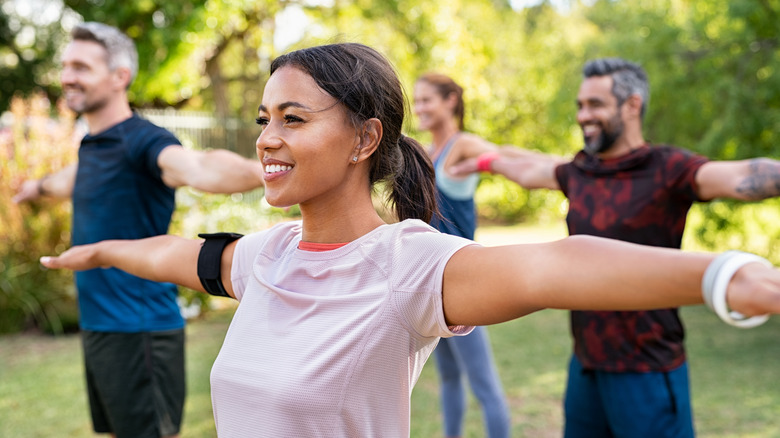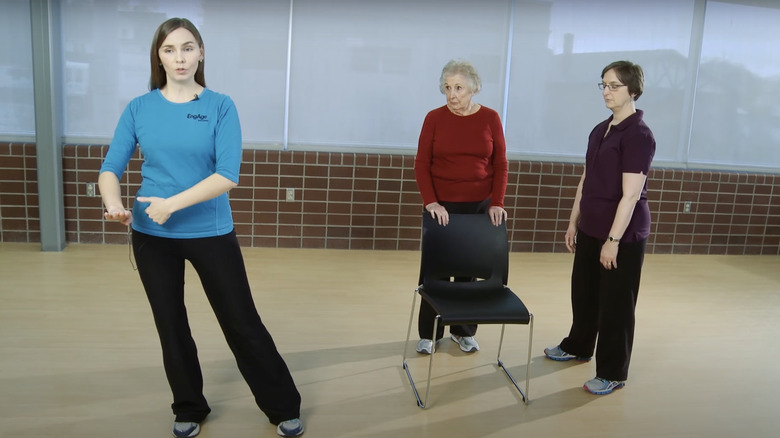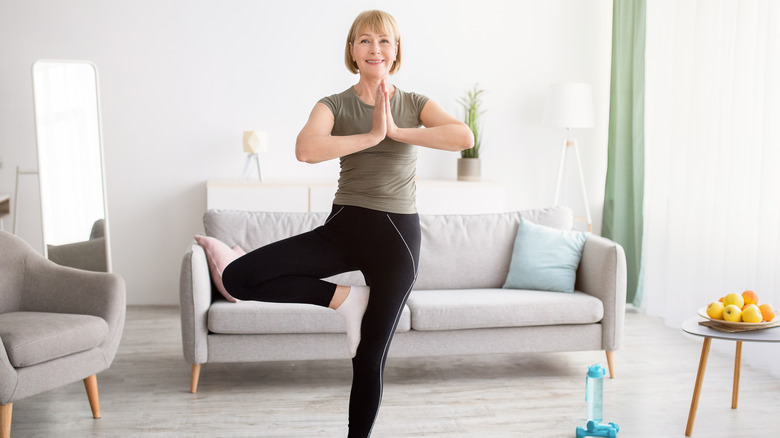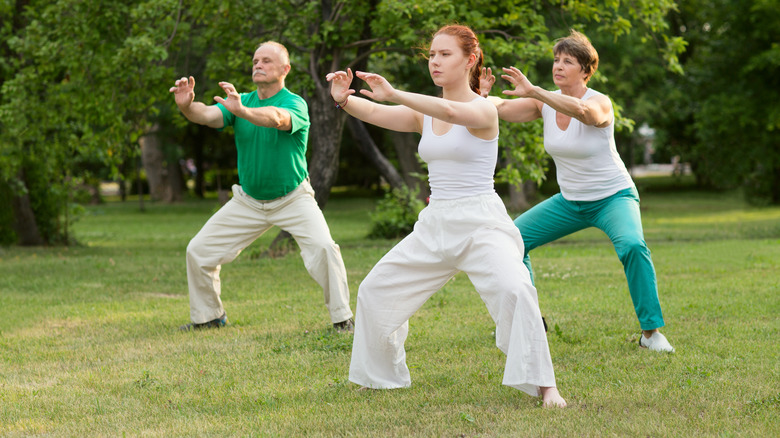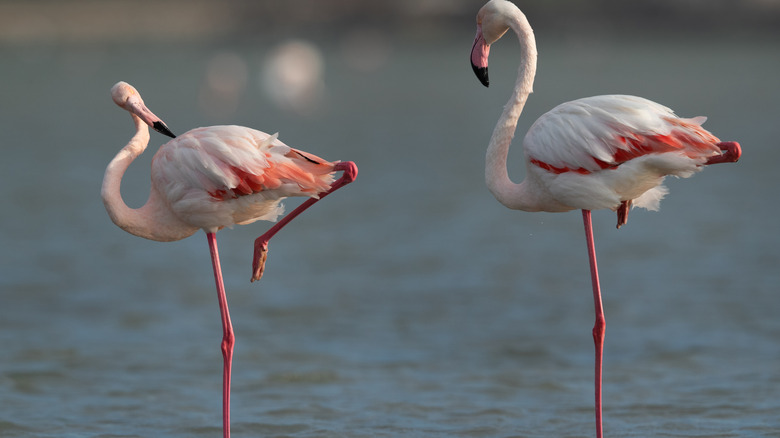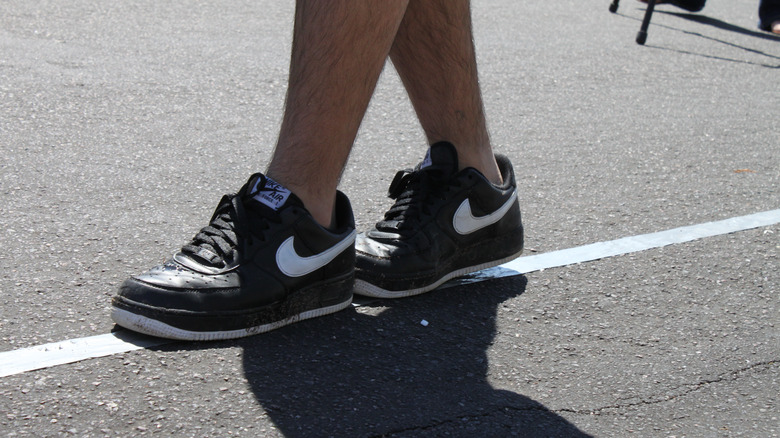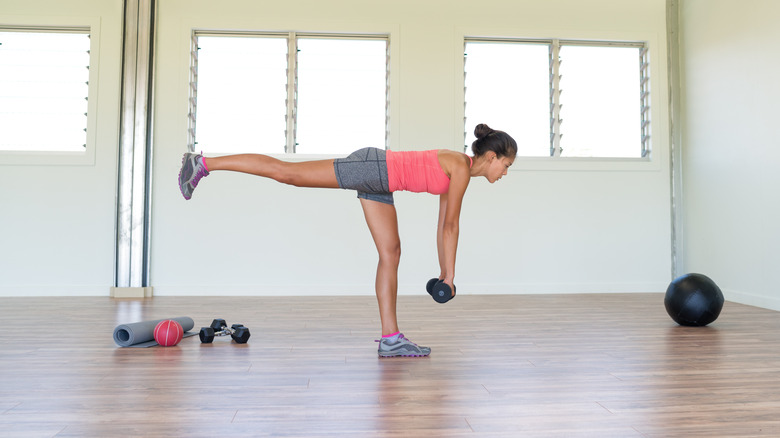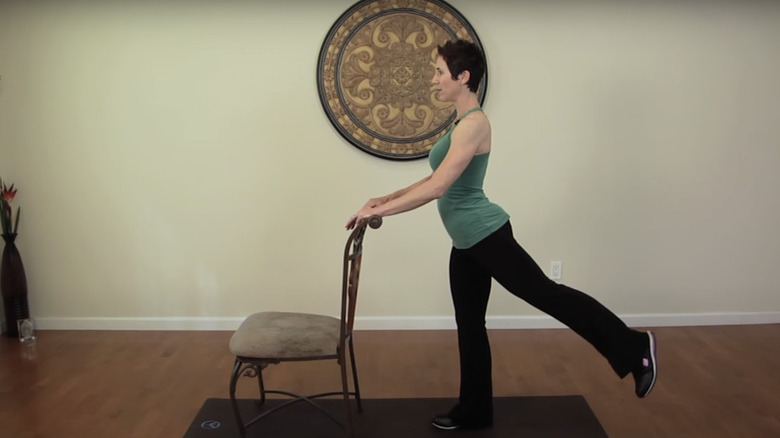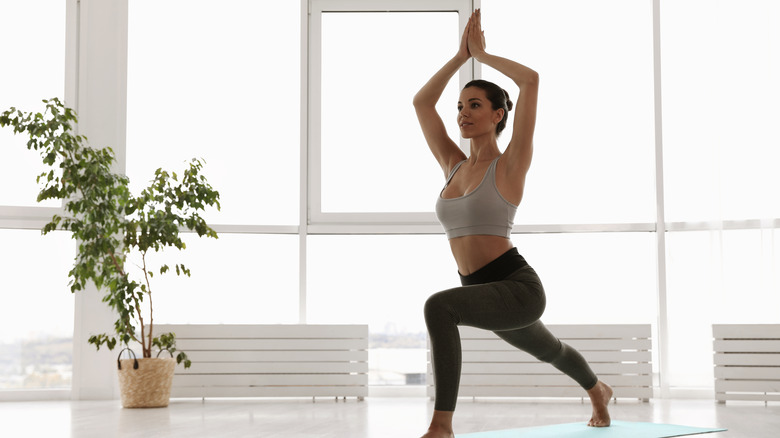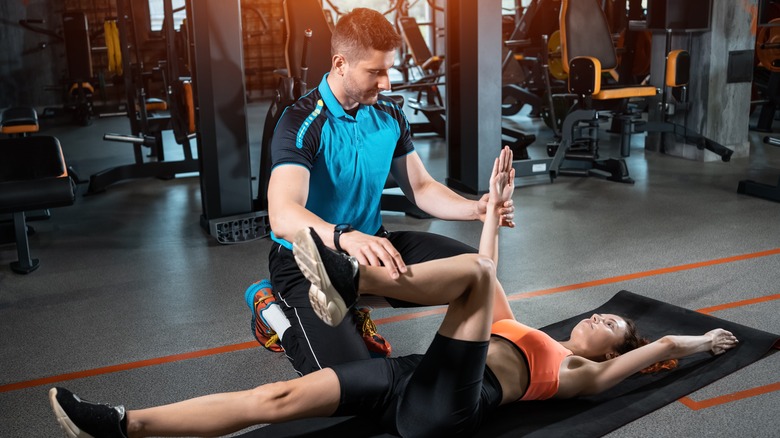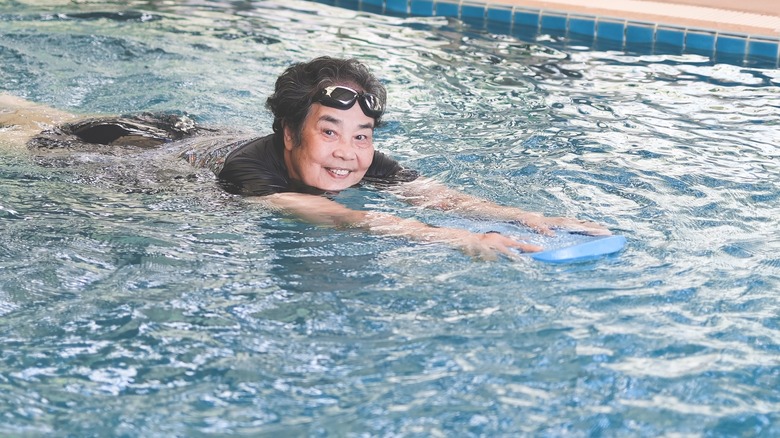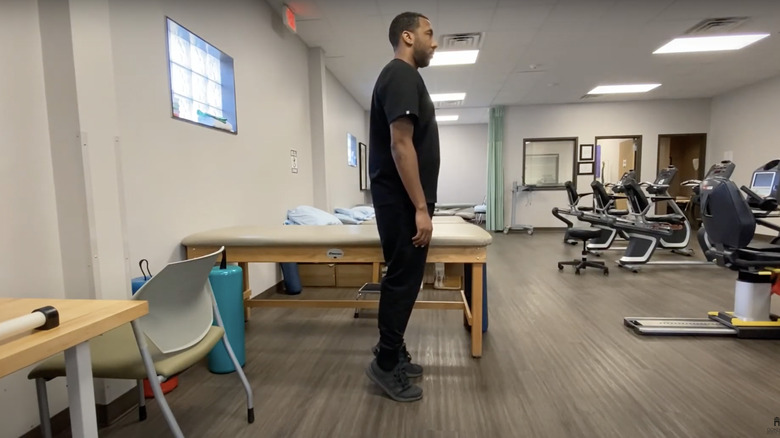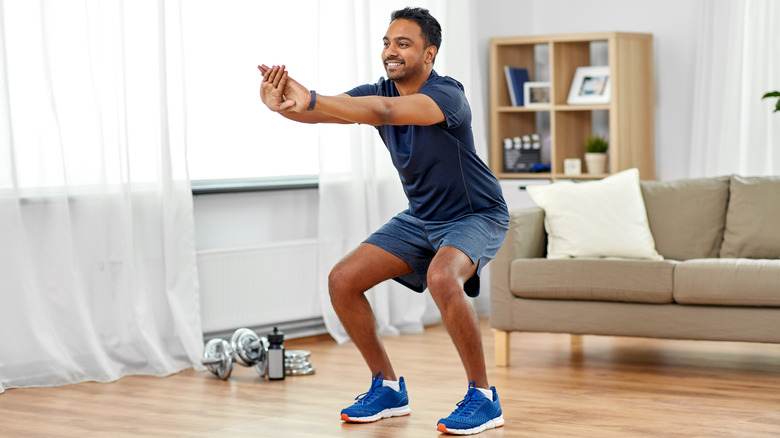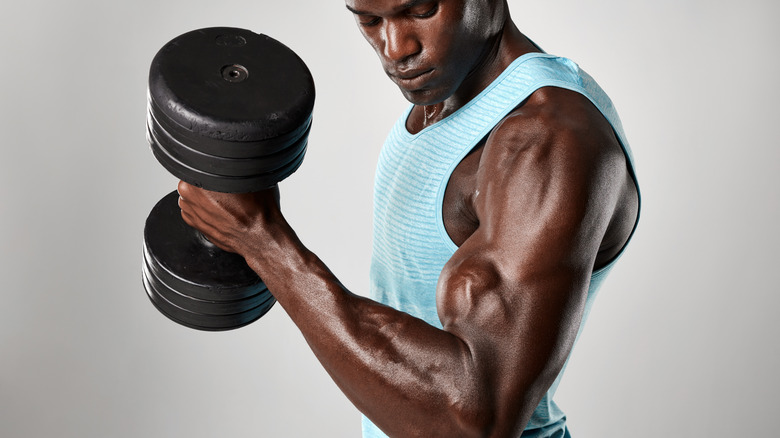The Best Exercises To Improve Balance
It sometimes feels like — when it comes to exercise — there's a certain order of benefits you should prioritize, with cardiovascular health and muscle tone often floating to the top. But focusing on improving balance isn't something most people do every time they work out. On a day-to-day level, though, maintaining good balance is important, allowing you to complete tasks with coordination and assurance, says Prevention.
And the older you get, the more important it becomes. "As we age, changes and deterioration of the musculoskeletal system (weaker muscles and loss of bone density) and loss of some motor skills can cause us to lose our balance more frequently," says Nicole Glor, NikkiFitness creator and fitness instructor.
Working on balance, therefore, allows you to minimize risk of an accident-based injury. Every year millions of older people experience a hospital visit due to a fall.
It's all very well saying you need to improve balance. But how do you actually do it? While you won't want for search results that show you how to get rippling abs or run your first 10K race, figuring out how to improve balance can be slightly more challenging. At Health Digest, however, we've done a lot of the homework. So, let's take a deeper dive into the best exercises to improve your balance. Ready, set, go!
Weight shifts
Sometimes, the simple moves are the best, and potentially the most deceptive. The act of shifting your weight from side to side may seem like an easy thing to do, but it's a subtle and challenging movement that will test and improve your balance. Begin by standing in the corner of a room with your feet shoulder-width apart, facing the opposite corner, according to the University of Michigan. The surface you're standing on should be supportive and firm, but potentially with a little give in it, like a foam pad. Keeping your feet planted on the ground, slowly shift your weight onto one side of your body, moving from your hips and ankles. When you've reached the limit of how far you can go, hold your weight there for five seconds, and then return to your starting position. Repeat the movement on the other side, alternating 10 times on each side.
Remember, while your feet should remain in place, it's okay to have a little movement in your heels, as they come slightly off the ground to accommodate the weight shifting. When you're more comfortable with weight shifts, try practicing them at a slightly higher speed to further challenge yourself.
Tree pose
Have you ever envied the poise and balance of a graceful yoga instructor? Well, even they had to start somewhere. And by practicing tree pose — a fundamental standing pose in yoga — you'll be engaging in balance work that will not only challenge your coordination but improve your connection with your body, and therefore your yoga practice, as a whole (per Yoga Journal).
To move into tree pose, start in Mountain Pose (for the complete yoga newbies out there, that's standing in an upright position, with your feet shoulder-width apart, shoulders back, and hands gently by your side). Find something fixed to look at in front of you to help with balance. Bring your hands up to your chest, in a prayer position. Gently shift your weight onto one foot, and then lift the other foot off the ground, keeping the planted leg straight — with a little give in the knee.
Maintaining balance in your planted leg, bend your elevated leg, and plant your foot on your inner right thigh, pushing both foot and thigh into each other. After five to 10 breaths in this position, remove your foot, lower it to the ground, and repeat on the other side.
Tai chi
Tai chi is almost as engaging to watch as it is to do. The slow, almost hypnotic movements of tai chi have been performed by people for generations and are not only suitable for all ages, but for people at any stage in their exercise journey. "You can start tai chi at most levels of health, and you can ramp up your activities to be appropriate to your level of fitness and function," advises Peter Wayne, Osher Center for Integrative Medicine's research director and Tree of Life Tai Chi Center founder, to Harvard Health Publishing.
And not only is tai chi a surprisingly impactful form of resistance training, helping to tone and shape muscles, but it's one of the best things you can do to improve balance. Its unique combination of control, flexibility, resistance, and range of motion works holistically to help people become more steady on their feet. Perhaps most impactful is tai chi's ability to ground the different components of your body, which assists in generating a better overall sense of poise, stability, and confidence in movement.
The Flamingo
Have you ever looked at a flamingo and at its uncanny ability to stand on one leg? Ever wished that you, too, could be so centered and elegant? Well, you can, by practicing a pose that draws its name from our pink feathered friends. And what's best is, that the flamingo pose, achieved by simply standing on one leg, works more than just your balance. "Standing on one leg makes you engage your core muscle in order to stop yourself from falling to the unsupported side," leading to a stronger overall core, says Tim Walker, Evolve Fitness founder and personal trainer, to The Guardian.
Start by standing with your feet shoulder-width apart, ideally barefoot, to heighten the connection of your feet to the floor. Gradually lift one foot from the floor, bending it behind you and leaning forward slightly, and then extend your arms to the side. Then, close your eyes. Focusing on maintaining your balance, hold the pose for 15 to 20 seconds. It can help to lightly touch your ear if you feel as though you're losing balance, to recenter yourself. Once done, return to the starting position, and do the pose again with the other foot, repeating several times a day.
Heel-to-toe walks
The tightrope is the ultimate symbol of balance. Watching individuals wander nimbly across an extended cord inspires awe in some and fear in others. But luckily, you don't have to suspend yourself 50 feet above the ground and risk life and limb to gain some of the balance that tightrope walkers have — and by gently emulating the exercise by doing heel-to-toe walks, you'll be gently improving stability while remaining on firm land.
Heel-to-toe walks couldn't be simpler, too. Begin by finding a long-ish straight line in your home or garden (or put a tape measure or long cord on the ground to walk on), explains Three Spires Physiotherapy. Then, gently walk from one end to the other, placing each front foot's heel just in front of the back foot's toe, so that they're touching every time. Walk to the end of the line, and then repeat the other way, keeping your feet connected with the line the entire time, not veering to the left or right. It's important to remember that the emphasis here should be on slow, controlled movement — there's no need to rush! The slower you move, the more you'll focus on (and train) your balance.
Single-leg deadlift
Some exercises are just built for versatility, and the deadlift is a great example of this. Not only can a deadlift be used to build serious strength and muscular endurance, but variations on the move can help improve different aspects of fitness. A single-leg deadlift can effectively work to bolster your balance, while also working your glutes and hamstrings, and can be done at any level of fitness (per Women's Health Magazine).
To start, stand in a neutral position, with your hands by your side or in front of you, holding the dumbbells lightly if using them. Slowly transfer your weight onto one foot, and lift the other leg behind you, while concentrating on a fixed point in front of you. Moving from your hips, lower your torso toward the ground while your leg simultaneously raised behind you, until your torso is in line with the floor. Hold the position briefly, and then return to your starting position, activating your glutes, hamstrings, and abs as you do so. Repeat for eight reps on each side.
Standing rear leg raise
Sometimes, the moves that look the most basic can be the most effective. Such is the case with the standing rear leg raise. The simple act of raising your leg behind you will simultaneously build lower-body strength and heighten your balance and stability, explains Muscle & Fitness. Stand in front of a wall or chair, and place your hands on it to support yourself. Then, slowly raise one of your legs backward, engaging your glute muscles as you do so. Hold briefly at the top of the motion, and then return to your original position.
While the standing rear leg raise looks easy, there are a few things to watch out for while you're doing it, to maximize the potential of the move. Don't try to push your leg too far backward and cause hyperextension, as this can put pressure and strain on your back. Make sure, too, that your torso doesn't tip forward while you're raising your leg. Ideally, you want your upper body to remain upright, with the movement being focused through your hips and legs.
High lunge
Mastering the lunge will take your exercise game from good to great, and trust us when we say that your body will thank you for doing so. The lunge is your lower body's best friend, with virtually all of your leg muscles being worked during the move, as well as serious activation through your core (per Healthline). And with a high lunge variation, you can hone in on your balance, while also getting additional stretch through your hip flexors to increase flexibility, says Nicole Glor, NikkiFitness creator and fitness instructor, to Prevention.
Start in a standing position, with legs shoulder-width apart, and then step one of your legs back so you're in a lunge, keeping your hands on your hips. Be sure not to overextend when you're stepping back: Your front leg should be parallel to the ground, with the heel of your back foot raised off the floor. Hold the pose for five deep breaths, with your hands remaining where they are, or stretching to the sky. Then, step your leg back up to standing, and repeat with the other leg.
Dead bugs
Focusing on your core is essential if you're trying to improve balance. Your core — comprised of both your inner and outer core muscles — is the power center of your body, and strengthening the muscles in this area allows you to remain coordinated and stable as you go about your day-to-day activities, explains the Mayo Clinic. And few core exercises are as effective as dead bugs. This easy-to-master move focuses on your core muscles which support and protect your spine, leading to heightened balance (per Healthline).
On a mat or supportive surface, lie with your back to the floor. Lift your legs so that your thighs are at a 90-degree angle to your body, with arms raised straight above you and also perpendicular to your torso. Then, slowly extend one of your legs out, while extending the arm on the opposite side backward, so that your arm and leg are in line with your body. Return your limbs to the starting position, and then repeat the motion on the other side. Here's where the movement gets its name: You should look like a dying bug flailing its limbs. Kinda cute, right?
Swimming
It's kinda hard to find an exercise that's as all-around beneficial as swimming, y'all. Let's take a look at some of the positives of regular swimming: In addition to helping prove overall muscle tone and strengthening your body, swimming also boosts your cardiovascular fitness and endurance — while doing so in a low-impact, joint-safe manner, says BetterHealth. Swimming is also an ideal exercise to encourage better flexibility, and provides a mental benefit; it's fun and calming.
But it's how swimming improves balance that we're particularly interested here, and if you're looking for a regular form of exercise to improve stability, swimming could be the one for you. It may prove especially advantageous for older adults' balance, with research published in the American Journal of Epidemiology finding a link between regular swimming and better balance, and therefore a lower risk of falls. While the study was conducted using only data from male participants, study author and University of Western Sydney associate professor of physical activity and health, Dafna Merom, says that swimming is likely to be as beneficial — if not more so — to women with regard to improving their balance (per Live Science).
Single-leg cross-body punches
To build balance, you have to challenge your body. Sometimes this challenge may be subtle, other times it's good to turn up the heat. That's exactly what you'll get with single-leg cross-body punches. By elevating one leg from the floor as you work your upper body, you'll be testing and improving your body's stability — with the punching motion performed with dumbbells providing a workout for your shoulders, biceps, lats, and triceps (per Spotebi).
Begin by holding a pair of dumbbells at your chest, with your elbows bent (per Healthline). You can also perform this movement without dumbbells, to take some impact away from your upper body. Lift one leg off the ground, and bend your knee slightly, so that you're in a very high squat. Make sure you remain strong through your planted leg — and then punch one, then the other arm across your body, ensuring that you don't hyperextend or move too quickly, as this may destabilize you. Perform 10 to 20 reps, then lower your raised leg to the floor. Repeat on the other side, for a maximum of three sets.
Heel-toe raises
The importance of balance increases as you get older. Not only does maintaining balance assist in reducing the risk of falling or injury, but it also allows you to remain confident in your everyday activities and movements, and not feel inhibited by doing the things you want to do (per Healthline). If you use a walker, prioritizing simple exercises that can be performed with your equipment is the best way to go, with heel-toe raises being an ideal choice.
Start by standing upright, with your walker or another stabilizing surface placed in front of or near you. Make sure your feet are fully connected with the floor (it can be beneficial to do your heel-toe raises barefoot, to heighten the connection with the ground). Gently raise onto the balls of your feet, and hold the position for three seconds. Then, drop your heels to the floor, and raise your toes off the ground, again for three seconds. Repeat the movement between 10 and 20 times, moving at your own pace — there's no rush!
Squats
When all else fails: Squat. There's a reason why squats are a fundamental component of any workout. This move will blast your lower body, with your hamstrings, quads, and calves all coming to the party, and your lower back and knee joints benefiting, according to Medical News Today. All of this strengthening action will inform your balance, too.
A basic squat will do more than enough to boost your balance. Start in a regular standing position, with your feet placed a little wider than hips. Then, gradually lower your butt and thighs so that your upper legs become parallel with the floor. Make sure that you're driving through your heels to do this, and your weight isn't rocking forward. When you're at the bottom of the movement, push up through your heels to a standing position, repeating 10 times for a full set. Squats aren't the easiest move for everyone, so if you have trouble doing them unsupported, try placing a chair underneath you, and lowering into it without using your hands for support, then standing.
Balancing bicep curls
We love a move that works more than one thing at once, and balancing-bicep-curls do just that. By combining a regular bicep curl with an additional challenge to your stability, you'll test your balance enormously, while also getting a great pump through your arms (per the Mayo Clinic).
Stand in a regular stance. Holding a dumbbell in one hand, lift the opposite leg off the ground. Then, perform a regular bicep curl, while balancing through your supporting leg, keeping things slow and controlled. Continue performing the bicep curl for as long as you can keep your form precise — and then rest, before performing the move with the opposing arm and leg. If this is too simple for you, mix it up with a few additional challenges. Try balancing on the opposite leg from the side that the weight's on, which will require more stabilization. You can also place something soft, like a cushion, under your foot, to make the move even harder.
